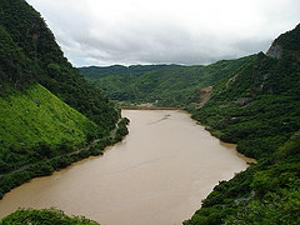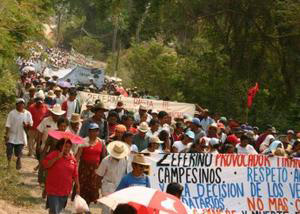 |
 |
 |
 News Around the Republic of Mexico | September 2007 News Around the Republic of Mexico | September 2007  
Judge Halts Construction of Mexico's La Parota Dam
 Environment News Service Environment News Service
go to original


| | The Papagayo River in Guerrero State. (Veronica MG) | 
| | People march in protest of La Parota Dam. (HHR News) |
Chilpancingo, Guerrero, Mexico - Lawyers for opponents of Mexico's proposed La Parota Dam filed a $10,000 judicial bond this week, ensuring that all construction on the massive dam stops at once.

The bond is part of a temporary injunction ordered by Mexican federal judge Lidia Larumbe on September 11 in support of a constitutional challenge against the project filed on behalf of local residents.

Local farmers and indigenous people oppose what would be a 531 foot-high dam on the Papagayo River in Guerrero state. If built, the dam would flood 17,000 hectares of forest and farmland in southwestern Mexico.

Judge Larumbe's decision, opposed by the federal attorney general, will be in effect until a verdict is reached on the constitutional challenge filed against the dam by the Mexican Environmental Law Center, CEMDA.

The lawsuit accuses the government and the government-owned electricity company - Comision Federal de Electricidad, CFE - of illegally granting environmental clearance and a water concession for the dam.

CEMDA said today that the judge's ruling was based on CFE's failure to consider the dam's impacts on public health and water quality, the seismic risks, unmitigated damages to biodiversity and the hydrologic system, faults in the public consultation process, and the effects on preexisting water concessions granted to the community of Cacahuatepec.

The lawsuit also charges CFE with human rights violations, failure to follow Mexican and international environmental law, and a refusal to conduct an open and transparent process in approving the dam.

CFE says the La Parota dam would displace 2,812 people, but opponents say some 20,000 people from 13 communities would be forced to relocate.

While the temporary injunction does not end the project, it does hand La Parota's critics a victory.

"This action sets an extremely important precedent," said Gustavo Castro of the Mexican Movement of Peoples Affected by Dams and in Defense of Rivers. "It is rare that protecting the environment and peasant communities would supersede the economic interests to build an infrastructure project of this magnitude."

The International Rivers Network, IRN, a California-based group that works to protect human rights and rivers worldwide, has worked with indigenous and campesino opponents of the La Parota project since it was proposed in 2003.

"It is impressive to see how the local people have organized to stop the dam," says Monti Aguirre, IRN's Latin America campaigner.

"The temporary injunction marks a significant victory for the communities, but unfortunately the Mexican government and dam proponents are determined to ram the project through," said Aguirre. "We will continue to support the community's efforts to protect their land and rights."

CEMDA and the Inter-American Association for Environmental Defense have also filed a critical report with UN special rapporteurs investigating human rights issues around the dam.

They charge an Environmental Impact Assessment filed by CFE ignored the project's location in a seismic area prone to earthquakes; failed to analyze the potential for vector-borne diseases like malaria; and did not address sedimentation issues that could affect the dam's performance.

CEMDA acknowledges that La Parota, in principle, constitutes a renewable energy project that would allow a reduction of Mexico's carbon emissions.

But, the law firm said today, this dam has not put in place "important measures of mitigation and compensation, like the creation of new protected natural areas, rescue of wildlife, control of water contamination and new risks to public health, ecological optimization of the hydraulic flow, and environmental control of the access roads."

Dam opponents say the CFE made no attempt to include the campesinos, local farmers, in the decision-making process regarding La Parota.

In July 2003, without giving notice or seeking permission, the commission sent in machinery to build two tunnels to divert the flow of the Papagayo River.

Farmers from surrounding communities responded with road blockades and encampments to keep CFE equipment out of the area. The ongoing roadblocks have been largely successful, and the CFE has been forced to pull out most of its equipment. At a demonstration against the dam in Chilpancingo, the state capital, the protesters numbered 30,000.

Not only do Mexican federal and state governments favor the plan, but also Carlos Slim Helϊ, recently named the richest man in the world by "Fortune" magazine - is also a promoter of the project. Slim owns ICA, the Mexican construction company most likely to win major contracts for the $1.02 billion project.

In June, as part of a global day of action aimed at sending a message to the Group of Eight, activists opposed to the dam held a demonstration in front of the Lloyd Center Sears in Portland, Oregon. They demanded that the Sears Holding Corporation cut all ties to Slim's company Grupo Carso. Slim has declared that Grupo Carso subsidiaries will be involved in every aspect of La Parota.

The dam proponents face equally determined opponents. Even though government forces have arrested, clubbed and tear gassed residents of the communities under threat, those communities still maintain roadblocks that prevent dam proponents from entering their villages.

Community leader Felipe Flores said, "A project cannot be imposed with blood and fire when people do not want it." | 
 | |
 |



